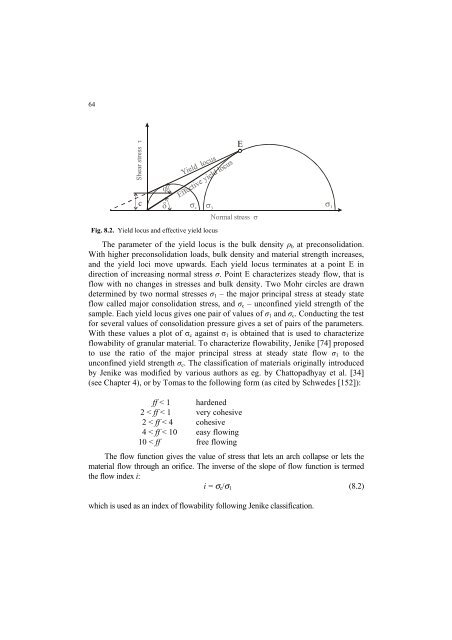Strona 2_redak - Instytut Agrofizyki im. Bohdana DobrzaÅskiego ...
Strona 2_redak - Instytut Agrofizyki im. Bohdana DobrzaÅskiego ...
Strona 2_redak - Instytut Agrofizyki im. Bohdana DobrzaÅskiego ...
You also want an ePaper? Increase the reach of your titles
YUMPU automatically turns print PDFs into web optimized ePapers that Google loves.
64<br />
Fig. 8.2. Yield locus and effective yield locus<br />
The parameter of the yield locus is the bulk density ! b at preconsolidation.<br />
With higher preconsolidation loads, bulk density and material strength increases,<br />
and the yield loci move upwards. Each yield locus terminates at a point E in<br />
direction of increasing normal stress 1. Point E characterizes steady flow, that is<br />
flow with no changes in stresses and bulk density. Two Mohr circles are drawn<br />
determined by two normal stresses 1 1 – the major principal stress at steady state<br />
flow called major consolidation stress, and 1 c – unconfined yield strength of the<br />
sample. Each yield locus gives one pair of values of 1 1 and 1 c . Conducting the test<br />
for several values of consolidation pressure gives a set of pairs of the parameters.<br />
:LWKWKHVHYDOXHVDSORWRI1 c DJDLQVW1 1 is obtained that is used to characterize<br />
flowability of granular material. To characterize flowability, Jenike [74] proposed<br />
to use the ratio of the major principal stress at steady state flow 1 1 to the<br />
unconfined yield strength 1 c . The classification of materials originally introduced<br />
by Jenike was modified by various authors as eg. by Chattopadhyay et al. [34]<br />
(see Chapter 4), or by Tomas to the following form (as cited by Schwedes [152]):<br />
ff < 1 hardened<br />
2 < ff < 1 very cohesive<br />
2 < ff < 4 cohesive<br />
4 < ff < 10 easy flowing<br />
10 < ff free flowing<br />
The flow function gives the value of stress that lets an arch collapse or lets the<br />
material flow through an orifice. The inverse of the slope of flow function is termed<br />
the flow index i:<br />
i = σ c /σ 1 (8.2)<br />
which is used as an index of flowability following Jenike classification.
















